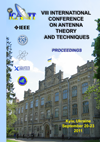Acoustic aerial for the experimental research sodar
DOI:
https://doi.org/10.1109/ICATT.2011.6170767Keywords:
turbulence theories, sodar remote sensing, sodar antenna system, turbulent pulsation spectrumAbstract
Complexity and semi-empirical nature of contemporary turbulence theories do not allow to expect reliable result interpretation sodar remote sensing data of an atmospheric boundary layer. Improving the method of processing requires the development of the experimental base and new experimental data. For example, it is necessary to have information about the spectrum of turbulent pulsation at different altitudes, their anisotropy, etc.
The report substantiates the requirements to the sodar antenna system intended for studying the dynamic and spatial characteristics of the turbulent streams.
Methods for problems solution are considered, the numerical experiment results and the aerial system elements tests are discussed.
References
MONIN, A.S.; YAGLOM, A.M. Statistical Hydromechanics. Part 2. Moscow: Nauka, 1967 [In Russian].
PANCHENNKO, A.Y.; MARYUKH, V.A. Effect of wove properties of directed sound beams of sodars in forming the field of reflected wave at ABL. Navigation and Communication Control Systems, 2009, n.4, p.42-46.
TATARSKIY, V.I. Wave Propagation in the Turbulent Atmosphere. Moscow: Nauka, 1967 [In Russian].
BORN, V.; WOLF, E. Foundation of Optics. Moscow: Nauka, 1970 [In Russian].

